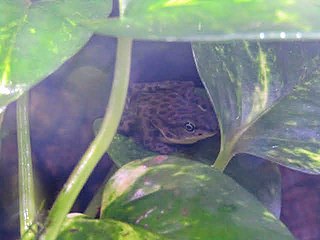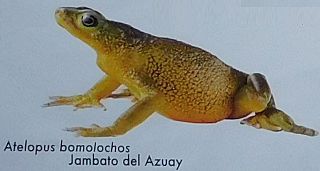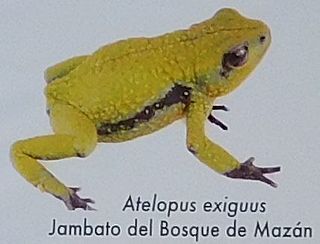
Atelopus is a large genus of Bufonidae, commonly known as harlequin frogs or toads, from Central and South America, ranging as far north as Costa Rica and as far south as Bolivia. Atelopus species are small, generally brightly colored, and diurnal. Most species are associated with mid-to-high elevation streams.

Atelopus longirostris is a species of harlequin frog, a member of the family of true toads (Bufonidae). It has been recorded only in northern Ecuador. Records from Colombia probably represent different species. As of mid-2017, it is listed as extinct by the IUCN, but was rediscovered in 2016 after more than two decade with no sightings, likely because the IUCN last assessed it in 2004. The scientific name of this species means "long-snout" and the species has been named in Spanish as the jambato hocicudo. Common names longnose stubfoot toad, scrawny stubfoot-toad, and longnose sharlequin frog have been coined for it.

Atelopus balios, the Rio Pescado stubfoot toad, is a species of toad in the family Bufonidae. It is endemic to southwestern Ecuador, with records from Pacific lowlands in Azuay, Cañar, and Guayas Provinces. It is a rare species that was already suspected to be extinct, but a single specimen was discovered in 2011 by a team from Conservation International during a hunt for missing amphibians. The decline in amphibian populations is well documented. The Atelopus balios is Critically Endangered as a result of the widespread amphibian Chytridiomycosis fungus that has decimated other amphibian populations. There are only 10 known findings of the tadpole, Atelopus balios.

Atelopus bomolochos, the Azuay stubfoot toad or Cuenca jambato frog, is a species of toad in the family Bufonidae. It is endemic to southern Ecuador and known from Cordillera Oriental in the Azuay, Cañar, and Loja Provinces.

Atelopus exiguus is a species of toad in the family Bufonidae. It is endemic to Ecuador and only known from the area of its type locality in the Azuay Province of southern Ecuador, in the sub-páramo and páramo of Cordillera Occidental. Common name Mazán jambato frog has been proposed for it.

Atelopus ignescens, the Jambato toad or Quito stubfoot toad or Jambato harlequin frog, is a species of toad in the family Bufonidae. It is endemic to the northern Andes of Ecuador. This once abundant species was believed to be extinct until its rediscovery in 2016. The specific name ignescens means "to catch fire," presumably in reference to the orange ventral color of this species.
The Mindo stubfoot toad or Mindo harlequin-toad is a species of toad in the family Bufonidae. It is endemic to Ecuador in Pichincha, Santo Domingo and Cotopaxi Provinces. Its natural habitats are subtropical or tropical moist lowland forests, subtropical or tropical moist montane forests, and rivers. It has a unique appearance and color pattern, being green and red with white speckles, and due to this it was once considered an emblematic species of the Mindo Valley.
Atelopus pachydermus is a species of toad in the family Bufonidae. It is found in the Andes of northern Peru and southern Ecuador. Records from Colombia reflect the vagueness of the stated type locality, "Neu-Granada", encompassing territory part of several present-day countries. Other records outside the current range refer to other species. The most recent record of this very rare and possibly extinct species is from around 1995. However, there is a need to reassess the status of this species because of confusion with Atelopus podocarpus.
Atelopus planispina is a species of toad in the family Bufonidae. It is endemic to the eastern slopes of the Andes of Ecuador. According to the IUCN SSC Amphibian Specialist Group, it is restricted to the Napo Province, although other sources suggest somewhat wider range. It has not been seen since 1985 and might already be extinct. Common names Planispina's harlequin frog, Napo stubfoot toad, and flat-spined atelopus have been coined for it.

Rhaebo caeruleostictus is a species of toad in the family Bufonidae. It is endemic to Ecuador and occurs along the lower western slope of the Cordillera Occidental at elevations of 40–2,000 m (130–6,560 ft) asl. The specific name caeruleostictus, from Latin caeruleus (=blue) and Greek stiktos (spotted), refers to the bluish colour pattern of this species. Accordingly, common name blue-spotted toad has been coined for it.

Osornophryne sumacoensis is a species of toad in the family Bufonidae. It is endemic to the Ecuador and only found in the forests surrounding a small crater lake on the eastern slopes of Sumaco, a volcano in the Napo Province.
Hyalinobatrachium munozorum, also known as Upper Amazon glass frog, is a species of frog in the family Centrolenidae. It is found in the upper Amazon Basin in Ecuador, Colombia, and northern Bolivia; it is presumably to be found in intervening Peru; earlier records from Peru have been assigned to Hyalinobatrachium carlesvilai.

Atelopus petersi is a species of toads in the family Bufonidae. It is endemic to Ecuador and is known from the Cordillera Oriental in the Napo Province and more provisionally, in the Chimborazo Province. The specific name petersi honors James A. Peters, an American zoologist who collected the first specimens of this species in 1962 and provided a description under the name Atelopus pachydermus. Common names Peters' stubfoot toad and Peters' jambato toad have been coined for it.
Atelopus onorei is a small species of bright yellow and green toads in the family Bufonidae. It is endemic to Ecuador and is only known from the vicinity of its type locality on the western slope of the Cordillera Occidental in the Azuay Province. It has not been seen since 1990 and may now be extinct, but it is possible that overlooked populations remain.

Noblella is a genus of frogs in the family Strabomantidae. They are found on the eastern slopes of the Andes and in the Amazon Basin in Colombia, Ecuador, Peru, Bolivia, and western Brazil. The name refers to Gladwyn K. Noble, who described the first species.

María Cristina Ardila-Robayo was a Colombian herpetologist. She was professor at the National University of Colombia, Bogotá, and worked closely with the Natural History Museum of the university. In 2010 she was credited as having described 28 new species of amphibians from Colombia; as of late 2018, the Amphibian Species of the World lists 31 valid species described by her. She also worked with caimans and crocodiles and lead biodiversity restoration projects.
Atelopus ardila is a species of frog in the family Bufonidae. It has not been seen since 1992, and is believed to be possibly extinct.
Atelopus pastuso is a species of frog in the family Bufonidae. It has not been seen since 1993, and is possibly extinct.
Atelopus gigas is a species of frog in the family Bufonidae. It has not been seen since 1970 and is considered possibly extinct.
Atelopus orcesi is a species of frog in the family Bufonidae. It has not been seen since 1988, and is believed to be possibly extinct.











